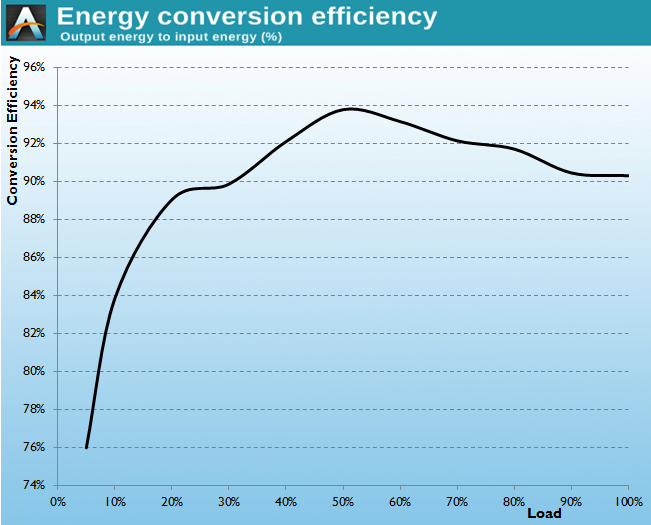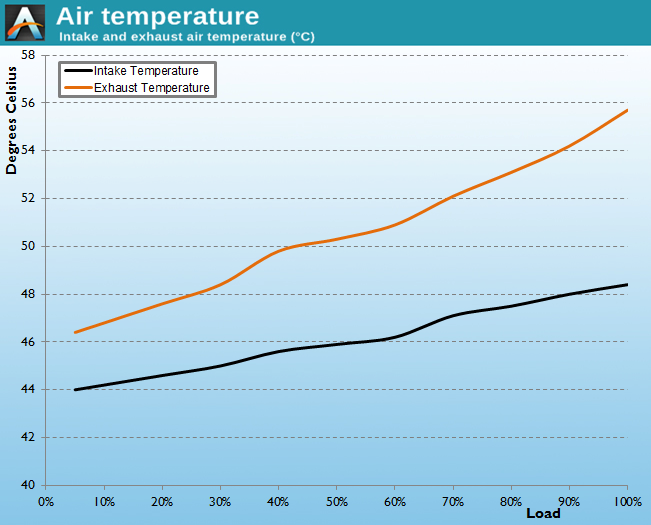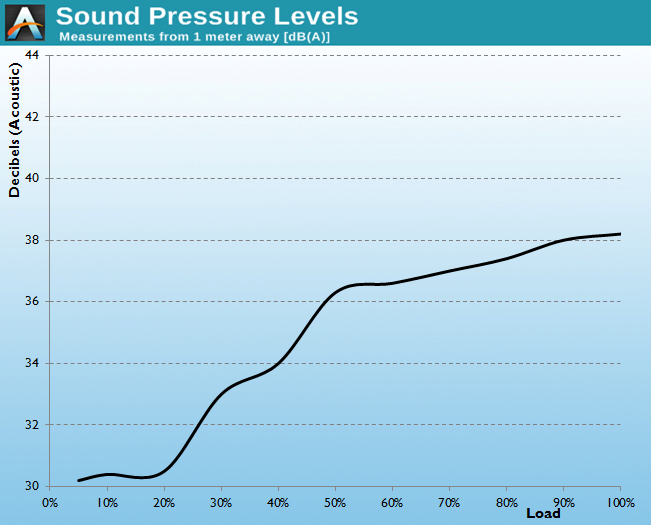Seasonic S12G 650W Power Supply Review
by E. Fylladitakis on February 28, 2014 2:20 PM EST- Posted in
- Cases/Cooling/PSUs
- Seasonic
- 80 Plus Gold
Hot Test Results
From the table below, it can be seen that the output power quality of the Seasonic S12G is very high. The maximum voltage ripple that our instrumentation recorded is a mere third of the ATX design guide suggested limit (the limits are 120 mV on the 12V line, 50 mV on the minor voltage lines), under full load and inside the hotbox no less. Cross-load testing negatively affects the power quality of any power supply but its effect on the Seasonic S12G is small, with the 12V line registering up to 54 mV while delivering 512W. Cross-load testing has virtually no effect on the minor voltage lines, the performance of which did not degrade any further than during standard testing.
| Line |
Regulation (20-100% load) |
Voltage Ripple (mV) | |||||
| 20% Load | 50% Load | 75% Load | 100% Load |
CL1 12V |
CL2 3.3V + 5V |
||
| 3.3V | 2.1% | 6 | 8 | 12 | 14 | 6 | 12 |
| 5V | 2.6% | 8 | 12 | 12 | 16 | 6 | 16 |
| 12V | 1.7% | 14 | 22 | 30 | 46 | 54 | 16 |
The impact that the higher ambient temperature has on the energy conversion efficiency is rather small, reducing the efficiency of the Seasonic S12G by about 0.5% across the entire load range. As such, the Seasonic S12G easily retains its 80 Plus Gold efficiency certification status even inside a very hot environment. The average efficiency between 20% and 100% load is an extremely high 91.6%.
The difference between our cold and hot tests is an increase of over 20°C ambient and, naturally, all of the temperature readings increase significantly. We dare say that the temperatures of the heatsinks rise quite a bit beyond our expectations of an 80 Plus Gold unit by Seasonic; however, the heatsinks are rather small and the design of the power supply apparently focuses on low-noise operation, so sacrifices are made in the area of temperatures.
The low-noise aptitude of the Seasonic S12G becomes apparent when we see that the fan hardly exceeds 38 dB(A) under the harshest of conditions, which is an audible figure but hardly louder than three or four 3.5" mechanical disks -- and never mind the GPUs that would be required to hit such loads. Nevertheless, unless you somehow manage to maintain the unit at maximum load inside a >50 °C environment, the Seasonic S12G will not get nearly hot enough to cause problems.














77 Comments
View All Comments
platos - Saturday, March 1, 2014 - link
I also want to see low wattage small form factor PSUs like the picoPSU and compatible bricks. I'm personally moving away from large desktops for my DIY PCs. I'm even hoping for pico and nano-ITX boards and cases to become popular.I'm guessing large desktops will mostly be confined to companies in the near future and they are more likely to buy PSUs as part of a complete system so they wouldn't directly care about individual PSU ratings.
E.Fyll - Saturday, March 1, 2014 - link
" My homeserver is pulling 35W from the wall right at this moment. "If you are not using a true RMS meter to read this figure, I am afraid that your actual power draw is way off. Especially with the PSU that you are using.
Daniel Egger - Sunday, March 2, 2014 - link
Actually that's what my APC UPS tells me which is also continuously read out so I also know the load profile over time and can even correlate with the temperature.Not too much of a fan reconnecting 24/7 servers too often from the mains just put different power reading hardware in between I must say.
From what I can tell the readings from the UPS is quite accurate: I've tested it with a variety of computer and other IT equipment using switching PSUs with a true RMS meter in between.
E.Fyll - Sunday, March 2, 2014 - link
The UPS has no true RMS reading, sorry...emn13 - Saturday, March 1, 2014 - link
It's the GPU's that are costing you. I've got a standard voltage, overclocked 4770k which is currently fully loaded and it's using 97W at the wall outlet; it idles at 20W - that's including power supply overhead. With some undervolting rather than overclocking I can get that down to 15W, with 1HDD and 3SSDs, but my motherboard isn't very friendly to undervolting so I decided it wasn't worth the bother.A single GPU, even if it's not the top of the line, can easily consume more than the entire rest of your system. You say you have two GPU's? Well, there you go: 20W for the base system, 20W for each GPU and you're in about the right ballpark.
mike55 - Friday, February 28, 2014 - link
Excellent article! I would definitely be interested in seeing an article about how to choose the right PSU. There is a lot of information out there, but a lot of it seems to suggest PSUs that can provide a lot more power than what I think should be necessary, resulting in less than optimal power conversion efficiency. It would be nice to see some more objective information. Although, I suppose there is some value in getting something over sized for future proofing. Especially for a quality PSU at less than $100.Egg - Friday, February 28, 2014 - link
IIRC the Seasonic X650 used to be this price with a modular interface. Well, I guess since the quality is just as good, and possibly even more efficient, we can hope for sales.tynopik - Friday, February 28, 2014 - link
where's the description of the cable?There used to be a chart breaking down each cable and the lengths to each connector:
http://www.anandtech.com/show/6168/rosewill-fortre...
also, isn't a shot of the wattage chart de rigeur?
extide - Saturday, March 1, 2014 - link
x2 these should be includedPcgeek21 - Friday, February 28, 2014 - link
I agree with Daniel; I would be very interested in the performance/efficiency of low wattage power supplies (200W-300W peak output). I run relatively low power servers at home 24/7 such that the 5W delta in power draw can add up over the 4-5 year lifetime of the equipment.I purchased an Antec EarthWatts EA-450 (http://www.eteknix.com/antec-earthwatts-platinum-4... several months ago for my current server. I would be very interested in determining if it was a worthwhile investment or if there are any better alternatives available on the market.
I look forward to more PSU reviews.